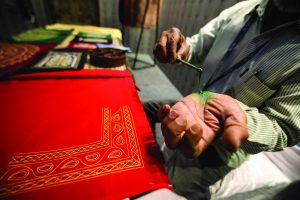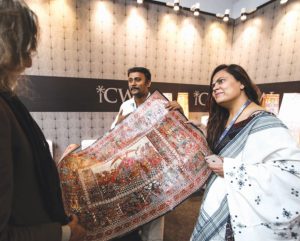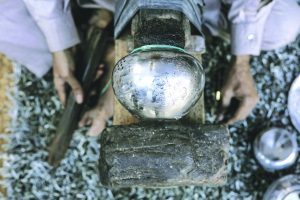 In India, fuse tradition with modernity on a single platform in a contemporary and collaborative manner is much necessary. Positioning crafts from just being ‘mediocre’, to ‘aspirational and desired’ is the solo reason behind various initiatives to promosoulte art.
In India, fuse tradition with modernity on a single platform in a contemporary and collaborative manner is much necessary. Positioning crafts from just being ‘mediocre’, to ‘aspirational and desired’ is the solo reason behind various initiatives to promosoulte art.
The national capital recently hosted the second edition of India Craft Week (ICW) to bring “handmade craft” to the forefront by bridging the gap between local artisans and customers from around the globe.
The five-day event (from 4-8 December) brought more than 150 participants including artisans, brands, designers, performers and eminent personalities to participate and interact with each other.
 ICW invited master craftsmen at one single platform and conducted almost 25 rare and exclusive workshops in the fields of textiles, stone carving, metalwork, ceramics, paintings and more. The aesthetic work done by some of the finest brands, organisations and individuals in the crafts industry were an interesting itinerary for this year.
ICW invited master craftsmen at one single platform and conducted almost 25 rare and exclusive workshops in the fields of textiles, stone carving, metalwork, ceramics, paintings and more. The aesthetic work done by some of the finest brands, organisations and individuals in the crafts industry were an interesting itinerary for this year.
Various initiatives to promote handcrafts have helped the traditional crafts and modern retail industry to evolve together. When the government is very keen to promote hand-made craft, platforms like ICW is changing the regular approach towards the craftwork.
National award winner Majid Mir, master of weaving Pashmina shawl participated in ICW’s second edition. He said, “On the platforms like this, we get to meet directly the consumer and buyer. The big thing is ICW is providing the platform for free of cost to promote our artwork.”
Mir, whose forefathers has evolved and innovated Pashmina weaving calligraphy centuries ago appreciated the initiative for inspiring the artists. He said, “We usually used to make shawls but then here we tried garments. Appreciation and encouragement help us to grow more. People also learn about the tedious process of making one shawl which creates awareness about our art and eventually helps us to earn our due.”
The fest started with the aim to celebrate fine artistry of hand-made craft and intends bridge the gap between global buyers and traditional artists. It also provides a common platform to promote the innovative ideas of Indian craft.
Another artist from Manipur, Mathew Sasa exhibited his unique artwork of hand-made black stone pottery at ICW. For him, these platforms create awareness about the artwork. He said, “20 years ago, very few people knew about black stone pottery art but our participation in different art fair and exhibition has got recognition to the artwork.”
 Black Stone pottery, unique in style and technique, is a traditional craft from Manipur. Mathew winning the National award has encouraged many. Till date, he has managed to train more than 300 people from his village, which helps them to make their livelihood.
Black Stone pottery, unique in style and technique, is a traditional craft from Manipur. Mathew winning the National award has encouraged many. Till date, he has managed to train more than 300 people from his village, which helps them to make their livelihood.
“The platforms like ICW are very helpful as we get to meet buyers directly and don’t have to pay stall rent. My earning has increased through these platforms,” Mathew added.
For centuries Indian culture has nourished the sustainable and organic methods, processes and materials of creating distinctive artworks. The initiative to bring back the focus on our century-old crafts and art forms will also benefit millions of craftsmen in the long run.
The traditional Rogan painting, which is on the edge of dying, is only practiced by two families in Nirona village in Kutch, Gujarat. Abdul Gafur Khatri belongs to one of the family out of two who has devotedly kept this beautiful Rogan art alive and thriving.
Khatri won the National award for keeping alive the oil-based fabric painting made of boiled oil and vegetable dyes. With time he has seen the changes in terms of design, material and trend. He said, “Earlier we were just doing the symmetrical work, now we have started working on the asymmetrical patterns as well. We were not able to work on hand-woven clothes but now we started making designs on woolen and hand-woven clothes. We are also experimenting with colours.”
Khatri sees this kind of platforms as two-way channel and believe that lead artist is incomplete without those local Craftsman and Artisans. He said, “People who visit this kind of a platform gives us the future opportunity, they consult us for tying up with their organisation. Here we do workshops and teach those who are interested in learning, which helps us to create contacts and links.”
“Local weavers are not getting the recognition they should get, the reason is lack of good platform and contacts. So it becomes important for an artist to take the initiative and step ahead to participate in such event and fair so that they can get some recognition,” Khatri added.
The unique segments like Craft Workshops, Craft Rare, Craft Panorama, Craft Luxe, Craft Installations, Craft Symposium and Craftscape were organised to learn from the experts. Much young art enthusiastic participated in the different workshops to share space with the masters to learn one of the finest art and craft.
Iti Tyagi, Founder of ICW talked about the vision and sustainable nature of the fest, said, “The initiative has been taken to educate children in their formative years to understand the importance of crafts in nation-building, livelihood, social inclusion and sustainable culture besides giving a major source of employment to millions of people.’
The fest like ICW has broadened the platform by including various kinds of craft like pottery work, paintings, Stitching, weaving, paper art and many more.
The metal handicraft like Bidri, originated in Bidar in the state of Karnataka is an example of extraordinary skills of crafting designs on the alloy of zinc and copper performed in four steps — molding, carving, inlaying and oxidizing.
For the art lovers, knowing these process and interacting with artists feeds their curiosity and also boost the artist’s enthusiasm. Shah Rasheed Ahmed Quadri, who is known for his excellent Bidri artwork and also won the National award try to connect with the people through his artwork. While engraving design on the vessel with chisel, Quadri said, “Everyone coming here is an art lover which give us a good response and recognition, and also help to earn money as per their hardship.”
Quadri also showed his grief of artists not getting what they deserves and sees this as one the reason behind declining numbers of craftsmen.
While moving ahead in the world of technology, art forms and handicrafts are still in demand for the old and antique work. To keep the authenticity while evolving with technology, artists need a space where they can grow and earn at the same time. To preserve the crafts that sit on the verge of extinction, it is necessary to educated, encourage and acknowledge the ingenious masters of folk and tribal crafts by representing their alluring artwork.
letters@tehelka.com













